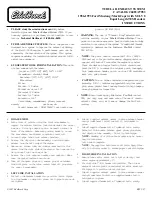
THERMOSTATICALLY CONTROLLED AIR CLEANER
SYSTEM
This system helps to improve fuel vaporization by controlling the temperature of the intake air almost at
a constant level automatically regardless of driving conditions and outside temperature, to distribute the
mixture to each cylinder evenly and to stabilize the air/fuel mixture ratio.
It consists of the
sensor
valve) and the Air Control Actuator (ACA). The
sensor
located in the air cleaner case senses the temperature of the intake air and controls the vacuum line by
opening and closing its passage to the ACA. According to this opening and closing operation, the vacuum
in the intake manifold actuates the damper through the diaphragm in the ACA. For the warm air, the air
is warmed up in the exhaust manifold cover and for the cold air, the outside air is drawn through the
fresh air passage and both enter the air cleaner.
“A” Warm air delivery mode
6
“B” Regulating mode
“C” Cold air delivery mode
1. ACA (Air Control Actuator)
2. Damper
3. Warm air duct
4.
sensor (valve)
5.’ Air cleaner case
6
6. Air cleaner inlet case
7. Carburetor
Intake manifold
9. Check valve
10. Diaphragm
11. Warm air
12. Cold air
13. Orange
System Operation
When engine is started in cold weather, the
valve is closed because the temperature of the intake
air in the air cleaner is low. Therefore, the vacuum is transmitted to the ACA diaphragm, which then
pulls up the damper linked to the diaphragm to open the warm air duct fully. As the engine is warmed up,
the temperature of the intake air coming into the air cleaner from the warm air duct rises and the
valve starts opening. As a result, the vacuum transmitted to the ACA diaphragm decreases, and the damper
pushed down by the spring force lessens the warm air duct opening. In this state, warm air and cold air
are mixed together and enters the air cleaner.
When the engine is operating at high rpm and under high load condition, the temperature of the air
coming from the warm air duct rises very high, causing the
valve opening to become even larger
and the damper opening smaller. That is, the amount of the warm air coming from the warm air hose
decreases and the cold air amount increases.
In this way, this system serves to maintain the temperature of the intake air going into the carburetor
almost at a constant level.
5-6
FIG. 5-1-4 TCAC system operation
Содержание Samurai 1986
Страница 1: ......
Страница 9: ...0 9...
Страница 10: ...0 6...
Страница 11: ...0 7...
Страница 12: ...0 8...
Страница 13: ...0 9...
Страница 14: ...0 10...
Страница 15: ...0 11...
Страница 19: ...1 2...
Страница 20: ...1 3...
Страница 119: ...r a l I 29 Fig 4 1 1 Carburetor exploded view 4 3...
Страница 120: ...N Fig 4 l 2 Carburetor cross section 4 4...
Страница 154: ......
Страница 155: ...T c c x 5 5 3...
Страница 347: ...Fig 17 1 34 17 12...
Страница 348: ...17 13...
Страница 353: ...Fig 17 2 12 17 18...
Страница 354: ...17 19...
Страница 360: ...Fig 17 3 19 Fig 17 3 20 Fig 17 3 21 5 Fig 17 3 23 Ci Fig 17 3 24 Fig 17 3 22 17 25...
Страница 379: ...Steering Lower Shaft and Joint Universal joint rubber joint bolt Steering rubber ir Fig 18 31 11 0 18 0lb ft 18 15...
Страница 424: ...Fig 19 6 1 19 38 19 6 PARKING BRAKE...
Страница 448: ...20 13...
Страница 450: ...21 2...
Страница 475: ...22 5...
Страница 476: ...22 6...
Страница 477: ...22 7...
Страница 478: ...22 8...
Страница 479: ...22 9...
Страница 480: ......
Страница 481: ......
Страница 482: ...Prepared by SUZUKI MOTOR CO LTD Technical Department Automobile Service Division 1st Ed November 1987 Printed in Japan...
















































